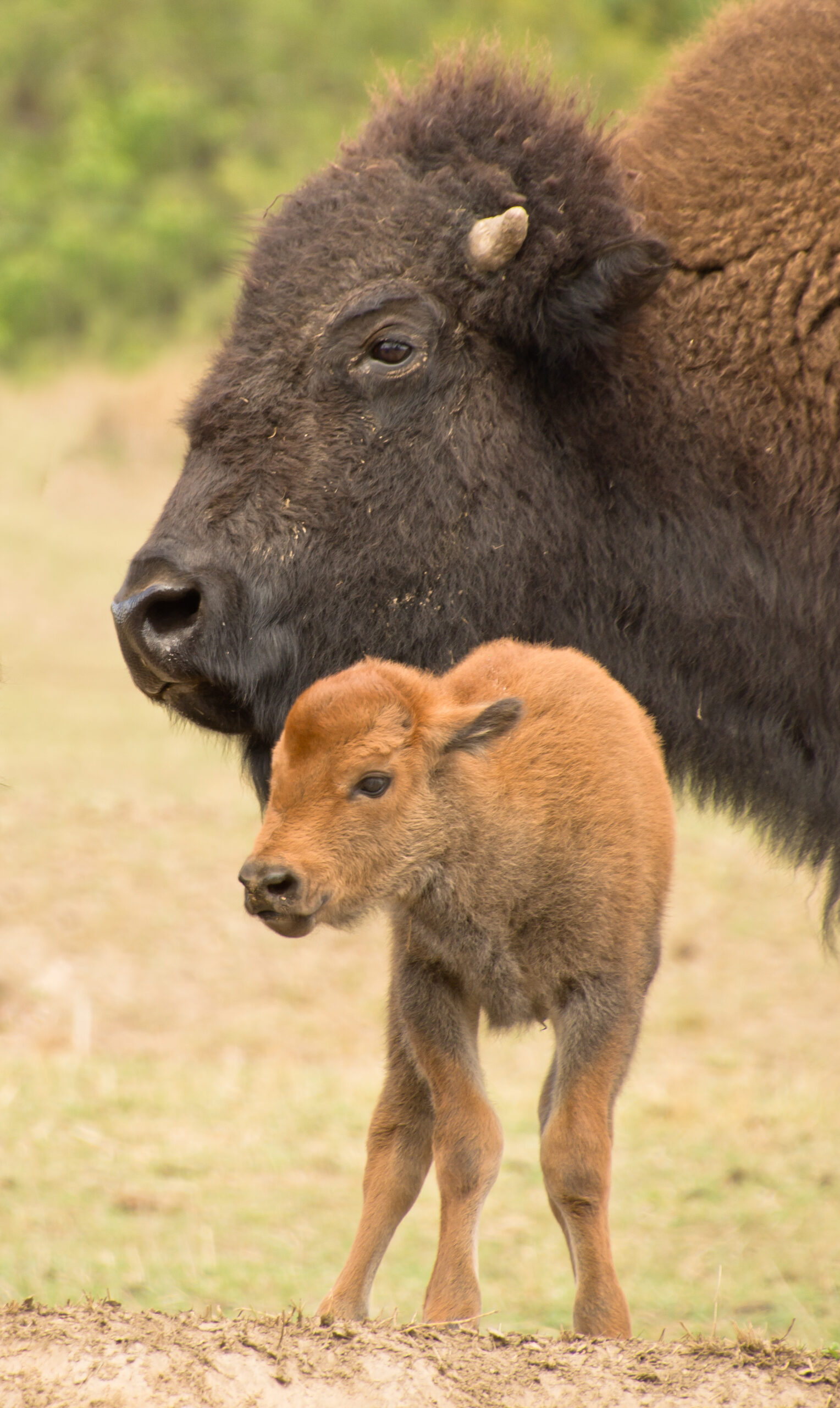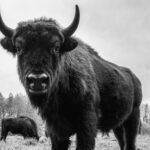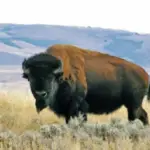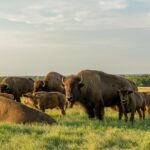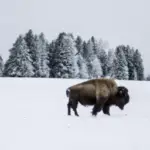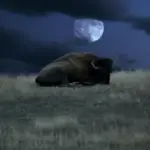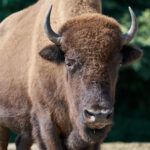Bison’s Lifespan in the Wild
Average Lifespan
The average lifespan of a wild bison typically ranges from 10 to 20 years. However, this can vary depending on various factors such as environmental conditions, predation, and disease prevalence.
Longest Recorded Lifespan
The longest recorded lifespan of a wild bison is 35 years. This remarkable achievement highlights the potential for individuals to surpass the average lifespan and thrive in the wild.
Factors Impacting Lifespan
Several factors can impact the lifespan of a bison in the wild. Predation, disease prevalence, and the overall quality of the environment play crucial roles. Additionally, access to sufficient food resources and suitable habitats can significantly impact their longevity.
Bison’s Lifespan in Captivity
Lifespan of Bison in Zoos
Bison in captivity, such as those housed in zoos, often have a longer lifespan compared to their counterparts in the wild. On average, bison in zoos live for 20 to 25 years. This can be attributed to the controlled environment, regular veterinary care, and access to a consistent food supply.
Lifespan of Bison in Nature Reserves
In nature reserves where bison are protected and managed, their lifespan can surpass that of wild bison. With reduced predation risks and availability of resources, bison in these reserves often live for 20 to 30 years. Proper population management and conservation efforts contribute to their increased longevity.
Influence of Human Care on Lifespan
The care provided by humans, whether in zoos or nature reserves, has a significant influence on bison lifespan. Regular veterinary check-ups, disease prevention measures, and appropriate nutrition can enhance their overall health and well-being, ultimately leading to a longer lifespan in captivity.
Comparison of Bison’s Lifespan to Other Animals
Comparison to Domestic Animals
Bison’s lifespan is relatively shorter compared to some domestic animals. While bison live for around 10 to 20 years, certain domesticated livestock, such as horses and cows, can live up to 25 or even 30 years. This disparity can be attributed to selective breeding for longevity and the controlled environments in which domestic animals often live.
Comparison to Other Wild Animals
When compared to other wild animals, bison’s lifespan is relatively average. They have similar lifespans to other large herbivores like wildebeest and musk oxen, both living on average for 10 to 20 years. However, it is worth noting that different species may face varying challenges and environmental factors that can impact their lifespan.
Comparison to Other Herbivores
In comparison to other herbivores, bison’s lifespan is relatively shorter. Some herbivores, such as elephants and giraffes, can live up to 60 years or more. The significant difference in lifespan can be attributed to various factors, including genetic adaptations, differences in environmental pressures, and reproductive strategies.
Impact of Predation on Bison’s Lifespan
Common Predators of Bison
Bison face predation from several formidable predators, including wolves, bears, and cougars. These predators often target young calves and vulnerable individuals, posing a threat to the bison population.
Defensive Mechanisms Against Predators
To counter predation, bison have developed various defensive mechanisms. Adult bison form protective groups, known as herds, which can deter predators through their sheer size and collective defense. Additionally, bison utilize their massive size and powerful horns to fend off or intimidate attackers.
Predator Impact on Bison Populations
Predation can have a significant impact on bison populations, particularly if their numbers are already low due to other factors such as habitat loss or disease. High predation rates can lead to decreased survival rates, disrupted social dynamics, and ultimately, a decline in the overall population size.
Impact of Disease on Bison’s Lifespan
Common Diseases in Bison
Bison are susceptible to a range of diseases, including brucellosis, bovine tuberculosis, and anthrax. These diseases can have a detrimental impact on bison populations, causing illness, reduced reproductive success, and ultimately leading to premature mortality.
Impact of Diseases on Bison Population
Diseases can significantly impact the lifespan of bison populations. Outbreaks of infectious diseases can result in mass mortality, especially among young and immunocompromised individuals. The spread of diseases can also have long-term consequences, affecting the overall health and genetic diversity of the population.
Prevention and Treatment Measures
Efforts are underway to prevent and treat diseases in bison populations. Vaccination programs, regular monitoring, and strict quarantine protocols are implemented to minimize the risk of disease transmission. Additionally, prompt treatment of infected individuals can help mitigate the impact of diseases on lifespan and population health.
Impact of Environment on Bison’s Lifespan
Impact of Climate
The climate plays a significant role in determining the lifespan of wild bison. Severe winters with deep snow and extreme cold temperatures can limit their access to food resources, leading to malnutrition and increased mortality rates. Conversely, milder climates with abundant vegetation can support healthier individuals and longer lifespans.
Impact of Habitat Quality
The quality of the bison’s habitat is crucial for their overall well-being and lifespan. A suitable habitat provides ample food sources, clean water, and adequate shelter. High-quality habitats result in better nutrition and reduced exposure to environmental stressors, ultimately promoting longer lifespans in wild bison populations.
Influence of Food Availability
The availability of food resources directly impacts the lifespan of bison. In periods of abundance, bison can access the necessary nutrients to support their health and survival. Conversely, food scarcity, especially during harsh winters or periods of drought, can lead to malnutrition and increased mortality rates, particularly among the more vulnerable members of the population.
Bison Mating and Reproduction’s Effect on Lifespan
Average Age of First Reproduction
Female bison, known as cows, generally reach reproductive maturity between the ages of two and three years. Male bison, or bulls, typically reach sexual maturity around the same age. Early reproductive age allows bison to contribute to the population’s growth at a relatively young age.
Significance of Reproductive Years
The reproductive years for bison span from early adulthood until senescence, typically between eight and twelve years of age. During this period, females can produce multiple offspring, contributing to the overall population size and genetic diversity. Successful reproduction and raising healthy offspring are crucial for the long-term survival of bison populations.
Effect of Mating on Mortality
Mating and reproductive activities can result in increased mortality rates among male bison. The intense competition for mates can lead to injury, exhaustion, and sometimes even death. However, the overall impact of mating on mortality rates for both males and females is relatively low compared to other factors such as predation and habitat quality.
Role of Genetics in Bison’s Lifespan
Inheritance of Lifespan Traits
Lifespan traits in bison, like in many other animals, are influenced by genetic factors. Certain genetic variations may contribute to increased longevity or decreased vulnerability to diseases. However, the complex interplay between genetics and environmental factors makes it challenging to pinpoint specific genetic mechanisms that influence bison’s lifespan.
Effect of Inbreeding
Inbreeding, which occurs when individuals within a population mate with close relatives, can negatively impact lifespan and population health. Inbred individuals are more susceptible to genetic disorders and reduced reproductive success. Conservation efforts strive to maintain genetic diversity within bison populations to mitigate the potential negative effects of inbreeding.
Genetic Diversity in Bison Populations
Genetic diversity is crucial for the long-term survival of bison populations. It ensures a variability of traits within the population, allowing for better adaptation to changing environmental conditions and increased resilience to diseases. Conservation strategies aim to preserve and enhance genetic diversity through the management of breeding programs and the establishment of protected areas.
Bison Populations and Conservation
Status of Wild Bison Populations
Wild bison populations have faced significant declines due to historical overhunting and habitat destruction. However, concerted conservation efforts have led to population recoveries in some areas, with stable to increasing numbers. Nonetheless, certain bison populations remain endangered or threatened, highlighting the need for continued conservation initiatives.
Conservation Efforts
Conservation efforts for bison include habitat protection, population management, and genetic monitoring. The establishment of protected areas and nature reserves ensures suitable habitats and safeguards these iconic creatures. Furthermore, collaborative conservation initiatives among various stakeholders, including governments, Indigenous communities, and conservation organizations, are vital for the long-term survival of bison populations.
Implication of Lifespan on Conservation Strategies
Considering the lifespan of bison is crucial when formulating conservation strategies. By understanding their lifespan and the factors influencing it, conservationists can develop effective management plans, ensuring the sustainability of bison populations and their ecosystems. Conservation efforts that address threats such as predation, disease, and habitat loss can contribute to increased longevity and genetic diversity, thereby securing the future of bison populations.
Does Cold Weather Impact the Lifespan of a Bison?
Cold weather bison survival tactics enable these majestic creatures to endure harsh winters. With their thick fur coats and large bodies, bison can withstand frigid temperatures. Their ability to graze on limited vegetation and survive without water for extended periods also contributes to their resilience. Despite the challenges posed by cold weather, bison have adapted well, ensuring their lifespan remains unaffected.
Future Directions in Bison Lifespan Research
Current Research Gaps
Several research gaps exist when it comes to understanding bison lifespan. More research is needed to evaluate the specific genetic factors that influence lifespan traits in bison. Additionally, the impact of climate change on their longevity and the effectiveness of various conservation strategies deserve further investigation.
Potential Impact of Climate Change
Climate change is likely to have implications for bison populations and their lifespan. Shifts in temperature patterns, altered precipitation levels, and changing vegetation dynamics can affect the availability and quality of food resources. Understanding these potential impacts will aid in the development of adaptive management strategies to mitigate the effects of climate change on bison populations.
Application of Modern Technologies in Research
The application of modern technologies, such as genetic sequencing and advanced monitoring techniques, can greatly enhance our understanding of bison lifespan. These tools can provide valuable insights into their genetic diversity, population dynamics, and susceptibility to diseases. By harnessing these technologies, researchers can contribute to more effective conservation strategies and better management practices for bison populations.
In conclusion, the lifespan of a bison in the wild typically ranges from 10 to 20 years, with some individuals living up to 35 years. Various factors, including predation, disease, environmental conditions, and genetic diversity, can impact their lifespan. In captivity, bison tend to live longer, with the support of human care and access to adequate resources. Understanding the factors influencing bison lifespan is essential for the conservation of this iconic species and the long-term sustainability of their populations. Further research, technological advancements, and collaborative conservation efforts are crucial for ensuring the continued existence of bison in the wild.

